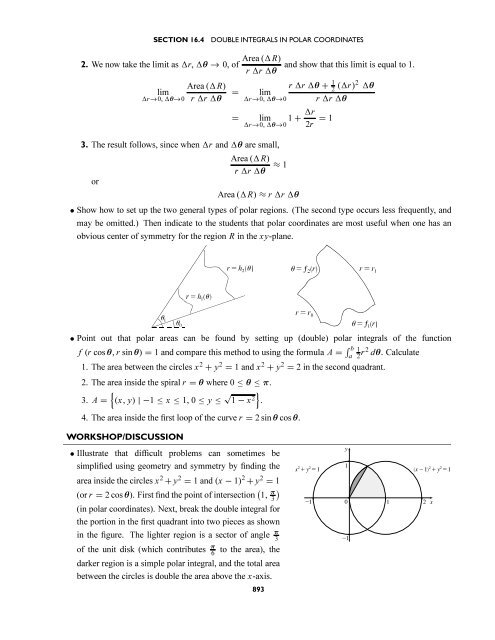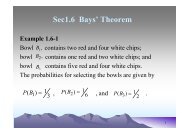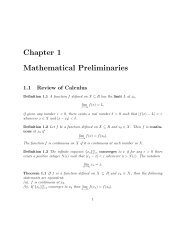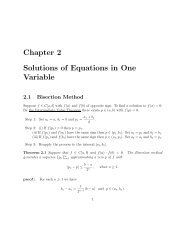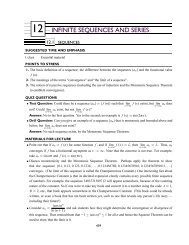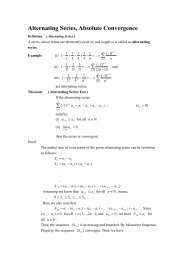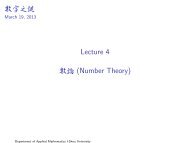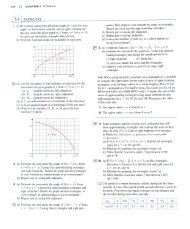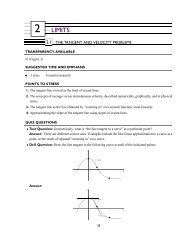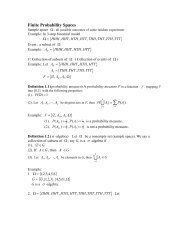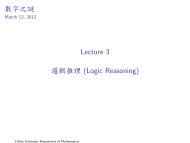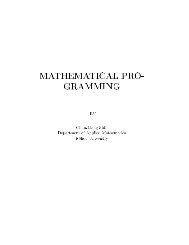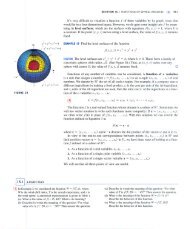16 MULTIPLE INTEGRALS
16 MULTIPLE INTEGRALS
16 MULTIPLE INTEGRALS
You also want an ePaper? Increase the reach of your titles
YUMPU automatically turns print PDFs into web optimized ePapers that Google loves.
SECTION <strong>16</strong>.4<br />
DOUBLE <strong>INTEGRALS</strong> IN POLAR COORDINATES<br />
2. We now take the limit as r,θ → 0, of<br />
Area (R)<br />
lim<br />
r→0,θ→0 r r θ<br />
Area (R)<br />
r r θ<br />
and show that this limit is equal to 1.<br />
r r θ + 1 2<br />
= lim<br />
(r)2 θ<br />
r→0,θ→0 r r θ<br />
= lim<br />
r→0,θ→0 1 + r<br />
2r = 1<br />
3. The result follows, since when r and θ are small,<br />
Area (R)<br />
r r θ ≈ 1<br />
or<br />
Area (R) ≈ r r θ<br />
• Show how to set up the two general types of polar regions. (The second type occurs less frequently, and<br />
may be omitted.) Then indicate to the students that polar coordinates are most useful when one has an<br />
obvious center of symmetry for the region R in the xy-plane.<br />
• Point out that polar areas can be found by setting up (double) polar integrals of the function<br />
f (r cos θ, r sin θ) = 1 and compare this method to using the formula A = ∫ b<br />
a 2 1 r 2 dθ. Calculate<br />
1. The area between the circles x 2 + y 2 = 1andx 2 + y 2 = 2 in the second quadrant.<br />
2.Theareainsidethespiralr = θ where 0 ≤ θ ≤ π.<br />
3. A =<br />
{(x, y) |−1 ≤ x ≤ 1, 0 ≤ y ≤ √ }<br />
1 − x 2 .<br />
4. The area inside the first loop of the curve r = 2sinθ cos θ.<br />
WORKSHOP/DISCUSSION<br />
• Illustrate that difficult problems can sometimes be<br />
simplified using geometry and symmetry by finding the<br />
area inside the circles x 2 + y 2 = 1and(x − 1) 2 + y 2 = 1<br />
(or r = 2cosθ). First find the point of intersection ( 1, π )<br />
3<br />
(in polar coordinates). Next, break the double integral for<br />
the portion in the first quadrant into two pieces as shown<br />
x@+y@=1<br />
_1<br />
y<br />
1<br />
0<br />
(x-1)@+y@=1<br />
1 2 x<br />
in the figure. The lighter region is a sector of angle π 3<br />
of the unit disk (which contributes π 6<br />
to the area), the<br />
darker region is a simple polar integral, and the total area<br />
between the circles is double the area above the x-axis.<br />
_1<br />
893


